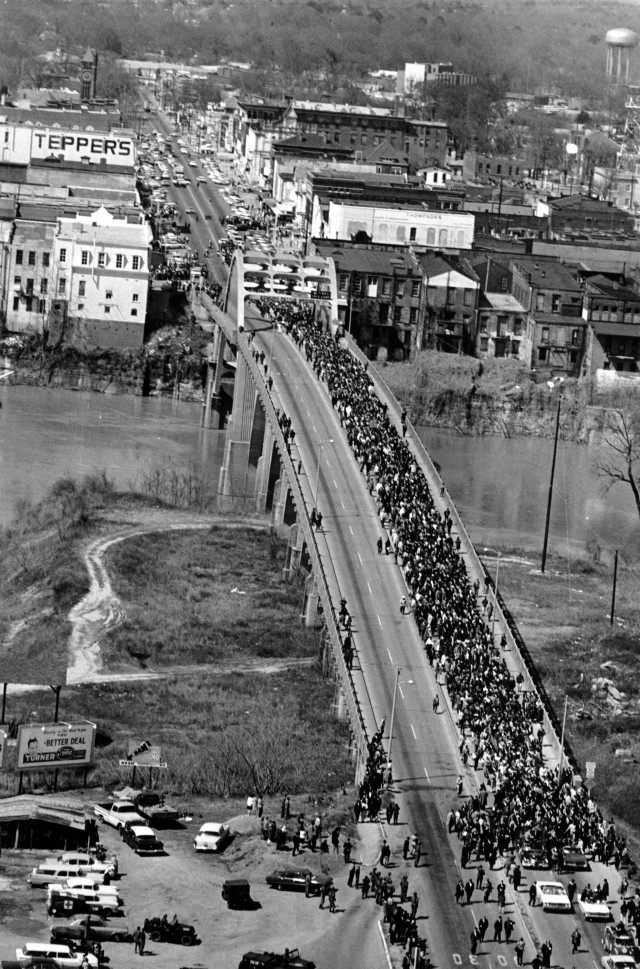SELMA, Ala. (AP) — When the nation’s first black president steps onto the Edmund Pettus Bridge to honor the marchers beaten there 50 years ago, he’ll be standing on a structure that’s at once synonymous with the civil rights struggle and a tribute to a reputed Ku Klux Klan leader.
The latter fact had all but faded from local memory until recently, when a Selma student group launched an online petition to rename the landmark bridge.
During his 50th anniversary address Saturday, President Barack Obama will be flanked on one side by a new historic marker commemorating “Bloody Sunday,” when white police beat demonstrators marching for black voting rights on March 7, 1965. The sign, erected earlier this year by the state tourism department, notes Obama’s 2007 appearance there just before his election and the accolades for “Selma,” the recent film about the march.
It offers no details about Edmund Winston Pettus, a Confederate general and U.S. senator who lived in Selma after the Civil War. The Encyclopedia of Alabama, an online database sponsored by the University of Alabama, Auburn University and the Alabama Department of Education, says Pettus held the title of grand dragon of the Alabama Klan in 1877 — an assertion that’s questioned by some historians.
Just beyond the other end of the bridge, a billboard erected recently bears a heroic image of another Confederate general, Klan founder Nathan Bedford Forrest. The ad, sponsored by a group dedicated to honoring Forrest, invites visitors to see Selma’s “War Between the States” historic sites; next month is the 150th anniversary of the Battle of Selma, in which Forrest fought.
As the “Bloody Sunday” anniversary approaches, a student group in Selma is petitioning to rename the bridge, whose twin metal arches soar above the murky Alabama River. The online petition, addressed to Selma Mayor George Patrick Evans and to the National Parks Service, has been up for about two weeks. It does not propose a new name for the bridge.
John Gainey, executive director of Students UNITE, a racially integrated youth group that began the petition, said having a white supremacist’s name attached to the city’s most visible landmark illustrates the city’s deep racial divisions a half-century after the marchers were beaten at the bridge.
Just as in the 1960s, Gainey said, Selma is split by race. Blacks attend public schools, most whites go to private academies and many blacks still live in run-down shanties while whites occupy nice homes with manicured lawns, he said. Yet the town of nearly 20,000 people is about 80 percent black.
“We think it really does represent something larger,” said Gainey.
The Rev. Joseph Lowery, a veteran civil rights leader, agrees the bridge’s name should be changed to quit honoring someone with alleged Klan ties.
“They’re responsible for too much death and misery. We don’t need to honor them,” said Lowery, a lieutenant of Martin Luther King Jr. who participated in the 1965 Selma-to-Montgomery march. “I’m with the kids. Let’s change it.”
However, Selma historian Alston Fitts doubts Pettus had anything to do with the KKK. Although the city was a hub of racial animus in the 1960s, Selma was known as a “safe place” for blacks aligned with liberal Republicans after the Civil War during Reconstruction partly because of a lack of Klan activity, he said.
“He was a pretty lousy Klan leader if that’s what he was,” said Fitts.
Pettus’ views on race were widely known during Reconstruction. In July 1871, when Pettus testified before a congressional committee investigating the Klan, he made it clear he believed whites, not blacks, were the victims in the post-Civil War South.
Pettus asserted that any campaign of intimidation was being waged by Republicans and “carpet-baggers” seeking to incite blacks to commit “acts of aggression on their part against the white people,” according to congressional archives.
Michael Fitzgerald, a professor of history at St. Olaf College in Northfield, Minnesota, is researching a book on Reconstruction-era Alabama. He said he hasn’t found “persuasive evidence” that Pettus was a Klan officer or even member, but he said Pettus was “almost certainly” involved with the White League, a later terrorist organization.
“He is a Confederate general, he is a Democratic leader when white supremacy is their slogan — is what they exist to do,” he said. “What I would say is Edmund Pettus is definitely a strong white supremacist.”
An attorney who entered the Confederate army as a major in 1861 and rose to the rank of brigadier general by 1863, Pettus was elected to the U.S. Senate in 1897 after Reconstruction and served until his death in 1907 at age 86.
Pettus’ legacy was still well known in Selma when the bridge was constructed just east of downtown in 1940, so the span was named for a man revered locally as a tenacious Southern leader. With Jim Crow laws still in effect, blacks had virtually no say in the decision.
And until now, there has never been a serious effort to rename it.
___
Breed, an AP national writer, contributed to this report from Raleigh, North Carolina.

COMMENTS
Please let us know if you're having issues with commenting.